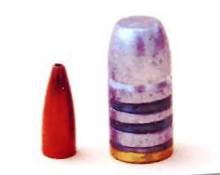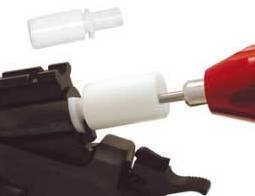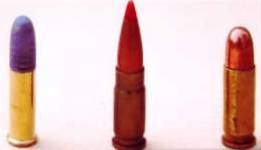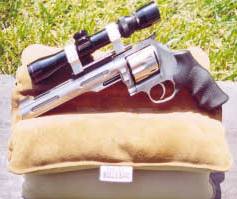From
time to time Iíll get a call from someone asking for load information from an
article that I had written some time in the past. Some times itís something from waaaaay back in the past. Unfortunately, Iíve gotten to the point that Iíve
published data on so many loads that I just canít remember them all unless I
happen to be using them for myself on a regular basis. When that happens, Iíll
have to take the personís name and number, hang up, run madly to the computer to
dig up the info, and then call back. Itís all good fun and thereís nothing I
enjoy more than to chat with silhouette shooters from literally all over the
world.
However, thereís a faster alternative if you have internet access. For
the last couple of years, all of my feature articles and Ranging Shot columns
have also been published on the Los Angeles Silhouette Clubís web site (www.lasc.us/ihmsanewsarticles).
This is probably the busiest silhouette site on the internet and gets around a
quarter million visitors, and the numbers keep edging upward. Obviously, not all
those visitors are silhouette shooters so itís safe to say that itís also one of
the very best advertising tools that IHMSA has to get the word out on our sport.
To quote a recent visitor "This is a great site".
Besides many other features, the LASC site has the most complete
collection of my scribbling's on the internet. The IHMSA web site also has some
of my technical articles as well, but the LASC site is the largest by far. If
you canít find what you want there, feel free to give me a call at any
reasonable hour. I live in the Los Angeles area so please take the time zone
differences into account.
Energy & Momentum - Speaking of phone calls. I got a couple recently asking about how much
velocity was needed to take down the rams reliably. Actually the shooters should
have been asking how much momentum was needed and how do you get it. A couple of
other callers asked how much energy was needed to take down the rams.
Obviously, thereís still a lot of confusion out there about this issue
of energy versus momentum, and which is the better way to estimate a loadís
effectiveness on a distant target. This isnít surprising since the ammo industry
still publishes energy ratings for its products in their catalogs and donít say
a single word about momentum. Additionally, most state fish and game departments
require that ammunition must develop certain minimum levels of energy to harvest
game. They also say nothing about momentum. So apparently everyone measures load
effectiveness by the amount of energy it develops - except us. Just rebels I
guess. So letís look at how these numbers are derived.
Kinetic energy is measured in foot pounds. To calculate kinetic
energy, first square the velocity, then multiply that value times the weight of
the bullet in grains, and lastly divide the result by the mathematical constant
450240.
From
time to time Iíll get a call from someone asking for load information from an
article that I had written some time in the past. Some times itís something from waaaaay back in the past. Unfortunately, Iíve gotten to the point that Iíve
published data on so many loads that I just canít remember them all unless I
happen to be using them for myself on a regular basis. When that happens, Iíll
have to take the personís name and number, hang up, run madly to the computer to
dig up the info, and then call back. Itís all good fun and thereís nothing I
enjoy more than to chat with silhouette shooters from literally all over the
world.
However, thereís a faster alternative if you have internet access. For
the last couple of years, all of my feature articles and Ranging Shot columns
have also been published on the Los Angeles Silhouette Clubís web site (www.lasc.us/ihmsanewsarticles).
This is probably the busiest silhouette site on the internet and gets around a
quarter million visitors, and the numbers keep edging upward. Obviously, not all
those visitors are silhouette shooters so itís safe to say that itís also one of
the very best advertising tools that IHMSA has to get the word out on our sport.
To quote a recent visitor "This is a great site".
Besides many other features, the LASC site has the most complete
collection of my scribbling's on the internet. The IHMSA web site also has some
of my technical articles as well, but the LASC site is the largest by far. If
you canít find what you want there, feel free to give me a call at any
reasonable hour. I live in the Los Angeles area so please take the time zone
differences into account.
Energy & Momentum - Speaking of phone calls. I got a couple recently asking about how much
velocity was needed to take down the rams reliably. Actually the shooters should
have been asking how much momentum was needed and how do you get it. A couple of
other callers asked how much energy was needed to take down the rams.
Obviously, thereís still a lot of confusion out there about this issue
of energy versus momentum, and which is the better way to estimate a loadís
effectiveness on a distant target. This isnít surprising since the ammo industry
still publishes energy ratings for its products in their catalogs and donít say
a single word about momentum. Additionally, most state fish and game departments
require that ammunition must develop certain minimum levels of energy to harvest
game. They also say nothing about momentum. So apparently everyone measures load
effectiveness by the amount of energy it develops - except us. Just rebels I
guess. So letís look at how these numbers are derived.
Kinetic energy is measured in foot pounds. To calculate kinetic
energy, first square the velocity, then multiply that value times the weight of
the bullet in grains, and lastly divide the result by the mathematical constant
450240.
Right away the astute reader has probably detected
the flaw in the formula which really makes kinetic energy a poor standard to
judge the effectiveness of a load. Hereís why. In order to determine the number
of foot pounds, the first thing we do is square the velocity. Velocity is
obviously the overwhelming factor in the formula and is given far more
importance than the bullet weight. Consequently, this can distort our
expectations of real world results. Let me give you an example.
If you go to Winchesterís ammo catalog, youíll see
that the factory 220 Swift load with its 40 grain bullet has a muzzle velocity
of 4050 fps. When you do the math to determine its energy rating at 100 yards,
youíll find that it carries an extremely impressive 1199 foot pounds of kinetic
energy at that distance.
Now turn a couple of pages and look up the numbers and do the math for
Winchesterís 300 grain 454 Casull load for the same distance. Youíll find that
it carries only 1141 foot pounds of energy. Thatís 58 foot pounds less than the
Swift. Does anyone reading this really believe that a 40 grain bullet will take
down a steel or a game animal more effectively than a 300 grain Casull bullet? I
hope not.
Letís talk momentum now. To put it
simplistically, momentum is the characteristic of a moving body to stay in
motion, even after it collides with another object. The formula for momentum
takes a more balanced approach to determining a result. Velocity is given less
importance and weight is given more. Momentum is determined by multiplying
impact velocity times the weight of the bullet in grains. That result is then
divided by the mathematical constant 225200. The solution is expressed in
pound-seconds.
|

|
|
"Which has more
punch? The 40 gr Sierra or the jumbo Leadhead? Some say the Sierra." |
|
So letís go back to our example again. If we calculate momentum for
the Swift at 100 yards, we get a result of .90 pound seconds. The Casull, the
the other hand is giving us over 1.74 pounds seconds. This is nearly twice as
much effect on the target even though the Swift is going over 2200 fps faster
than the 454 at the moment of impact! Think of it. Over 2200 fps faster.
This example illustrates how an over
emphasis on velocity can distort our expectations of load effectiveness. It also
illustrates why momentum is a much more realistic method to estimate load knock
down potential.
So how much is enough? First of all
there are no guarantees in life. Sometimes, in spite of the numbers, the ram
doesnít fall. Stuff happens. That being said, ideally weíd like to have 1.0
pound seconds of momentum for the full size rams if we can get it with safe
pressures. However, values a lot less than that can work just fine depending on
the condition of your targets and target rails. Iíve seen loads with a momentum
value of .75 pound seconds work very reliably. However, Iíd hate to go lower
than that.
On the other hand, exceeding 1.0 pound
seconds is very rarely worth the trouble or the abuse on you, your gun, and your
brass. Donít bother. If your load is developing between .8 and 1.0, there should
be no problem.
Bore Guides - I think that most people these days accept the fact that a bore guide
is a highly necessary piece of equipment when cleaning our barrels. Bore guides
are usually plastic inserts that fit into the chamber of our gun and keeps our
cleaning rods centered in the bore, making sure the rod isnít rubbing against
the sides and causing unnecessary wear on the lands.
Even high quality plastic coated rods can cause wear without a bore
guide because theyíve picked up abrasive grit from the ash and powder debris
left behind from our last firing session. When that stuff gets on a cleaning
rod, it turns it into the equivalent of a very fine round file working on the
interior of your barrel. It may take a while, but eventually metal wear is
inevitably going to occur.
While bore guides for rifles are pretty ubiquitous, theyíre not that
widespread for single shot pistols. Fortunately for owners of the XP-100, which
is based on a rifle action, bore guides are available from several sources.
Similarly, Contender owners hit the jackpot back in 1996 when
Sinclair
International (260-493-1858) came out with a line of inexpensive bore guides.
Since then, theyíve also added additional guides for the Encore as well. I have
several of these and I wouldnít clean my Contenders or Contender carbines with
anything else. However, if youíre a MOA or BF owner, finding a bore guide is
very problematic.
|

|
|
"Sinclair TC bore guides are a must for
safe barrel cleaning" |
|
There is a simple solution to this situation however, and that is to
use an old cartridge case that has been fired in the gun in question. All you
have to do is drill out the primer pocket flash hole large enough so that a
cleaning rod can be passed through. You now have a bore guide that will fit your
chamber exactly. It works and the price is certainly right.
224 Montgomery - I was scrounging through a desk drawer the other day and came across a
224 Montgomery cartridge that I hadnít seen in probably five years. Tim
Montgomery is the guy that runs our marksmanship program and is one of those
tireless workers that keeps doing his thing year after year for IHMSA and
doesnít get a darn thing out of it, except perhaps grief.
Anyway, Tim, who likes to have fun with things, cooked up this idea
for this new cartridge for his TC. Basically, itís a 25 ACP necked down to .224
inches. Last time I talked to Tim about this inspiration (some time ago), he
said he could get sub one inch groups on a still day at 100 yards. A typical
load for the Montgomery is 1.8 grains of Bullseye, or 2 grains of Unique with a
40 grain Hornady V-Max or a Nosler 40 grain boat tail. Considering that there
are 7000 grains in a pound of powder, a can of Bullseye will last a long time.
|

|
|
"224
Montgomery (C) flanked by a
Lapua Scoremax rimfire (L) and a Winchester 25 ACP (R)" |
|
These loads will produce
around 1300 feet per second out of his 1:12 twist barrel. I imagine that
Tim is probably getting around 1800 fps with the newer 35 and 33 grain
bullets from Hornady and Speer now. Then thereís also the 30 grain Berger
which would be perfect for the little case. Iíll bet a TC chambered in the
Montgomery would be perfect for shooting rats down at the local dump.
Little noise, no recoil, and deadly accurate.
Sand Bags & Such
Things - I often use an Uncle
Budís butterfly shaped sand bag when I do load testing at the range. They
come in two sizes - one for pistols and a longer one for rifles. The main
customers for these bags are varmint shooters who like to splatter the
nasty little critters with their specialty rifles when shooting from the
hoods of their trucks. Because of the design and the fact the top is made
from suede leather, the bag grips the stock of your gun in a very snug
manner and makes a very stable platform from which to shoot.
|
 |
|
"Large sandbags like the Uncle Bud's
(shown with a Dan Wesson 360) can be a heavy haul to the range" |
|
The bad news is that because theyíre so large, when filled with play
sand from Home Depot, they weigh 40 pounds. Lugging one of those any kind of
distance is no fun. Even a single, regularly sized sand bag will weigh around
8-10 pounds each. When checking out loads with regular bags, Iíll use a stack of
six. So hauling these things from your car to your shooting bench can be a
muscle straining hassle.
Lynn Hayes gave me this tip to get around this problem several years
ago and it works great. When filling your sand bags, use rice instead. Itís nice
and light and it fills the bags just as well as sand. No more straining to carry
it back and forth from the car. The rice filled bags also conform around the
contour of your gun even better than sand for a better grip. The really
interesting thing about using rice is the fact that when you buy it in the
really big bags, the cost isnít a whole lot different than what a big bag of
sand costs. Figure that out. So if someone says food is as cheap as dirt, itís
probably true. Now over time and with rough treatment, the rice grains might
break up and become smaller causing the bag to loosen up and start to lose its
shape. This will require you to add a bit more rice from time to time to get the
bag firmed up again, but itís no big deal. Any rice left over after you fill
your bags can then be put in a steamer and can end up on the dinner table. What
a deal.
![]()